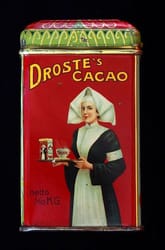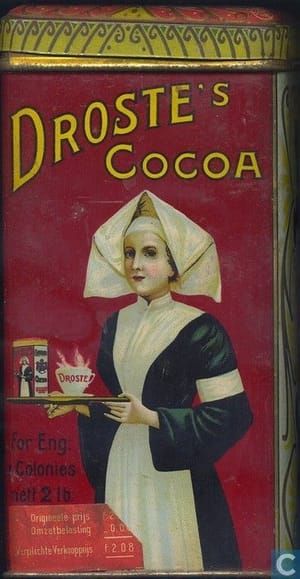

Packaging art for Droste's Cocoa, 1904
Jan Misset
In 1904 the Haarlem advertising painter Jan Misset designed new cocoa packaging for the manufacturer Gerard Droste. To emphasize the medicinal effects of the product, Misset depicted a nurse holding a tray on which sits a cup of steaming chocolate milk and a cocoa tin. This same scene is repeated on each successive tin, and so on: the Droste effect. The entire image is repeated ad infinitum on each tin pictured, in an increasingly smaller scale.
...On the oldest tin, the nurse wears a red cross - which was soon banned. In an American version, the nurse was replaced by a farmer and his wife. Dating of the tins is easy on the basis of the curvature of the text.
...Does the Droste effect justify an independent exhibition? In painting, the number of Droste effects which appear before the Droste tin is strikingly thin, as noted by art historian Lieneke van Wees in the booklet accompanying the exhibition. The painting of the Albertus Horstman family by Casparus J. Morel from 1823, with a painting on a wall on which the scene is repeated, comes the closest. There are more 20th-century examples, such as the repeating skulls in Dali's 1940 Le visage de la guerre.
...In its pure form, the Droste effect is an image which repeats itself within that image, on a smaller scale and necessarily to infinity. Fractals, such as the Sierpinski sieve (1916), are the geometric abstraction of this....
[Google translation of text at https://www.nrc.nl/nieuws/1994/08/24/hete-chocolade-tot-in-het-oneindige-verkleind-7236098-a1373396]
In 1906 the Haarlem cocoa and chocolate manufacturer Droste brought to market a cocoa tin to showing a nurse holding [a tray showing] the same cocoa tin with the same nurse etc., etc. This suggested infinity is now known worldwide as the Droste effect.
...The image was probably designed by the Haarlem advertising artist Jan Misset. He based his nurse on the pastel 'La serveuse au chocolat' by the Swiss artist Jean-Etienne Liotard. This pastel from 1743 shows a maid holding a tray on which sits a cup of chocolate milk and a glass of water.
Google translation of text at https://hetpronkstukvannederland.avrotros.nl/stemmen/het-droste-cacaoblik/]
The Droste effect, known in art as mise en abyme, is the effect of a picture recursively appearing within itself, in a place where a similar picture would realistically be expected to appear.
The effect is named for a Dutch brand of cocoa, with an image designed by Jan Misset in 1904. It has since been used in the packaging of a variety of products.
[https://en.wikipedia.org/wiki/Droste_effect]
Uploaded on Apr 1, 2018 by unknown user
Jan Misset
artistArthur
Wait what?

